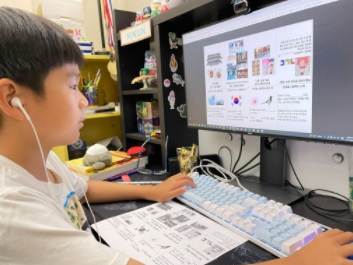“Ahn-nyeong-ha-se-yo!”
With vibrant voices greeting each other in Korean, the Korean class at Korean Institute of Southern California (KISC), Irvine, begins.
Every Saturday morning from 9 a.m. to 12 p.m, elementary school students attend classes to learn Korean at KISC, Irvine. This year, the classes are virtual because of the continuing COVID-19 pandemic. However, the online classes do not undermine the students?and teachers’ passion for learning and teaching Korean to more people. The sleepy eyes of the students on an early Saturday morning open with the teachers‘ beginning presentation. Typical classes at KISC mainly consist of programs that can advance the students’ understanding and skills used in the Korean language. The beginners, usually first to third graders in elementary school, start learning the basic Korean alphabet, Hangul. As they continue improving on the language, various opportunities for experience, using grammar and speaking skills, are professionally prepared and provided by the teachers and student assistants.
The classes are divided based on the different grade levels of the students, to offer the curriculum that fits them best. However, the students can feel free to change the class level depending on their needs in the area of Korean learning.
The biggest advantage of learning Korean is gaining the ability to communicate. 밚earning Hangul is really helpful for me because I can communicate well with my family.?Minjun Gal, from Canyonview Elementary School and KISC Irvine, said. Language education reunites and strengthens the bond between family members and precious people.
The lessons at KISC do not stop at merely learning the Korean language. Regarding the institution뭩 purpose of helping Korean Americans/immigrants to preserve their identity, its program also involves class sessions to educate about the topic of Korean culture. 밒t was so much fun to make song-pyeon with my classmates,?Minjun shared about his experience during the class. 밯hile making song-pyeon and using Korean, I could know even better about chu-seok, which is the Korean traditional holiday.?The culture sessions at KISC have been presenting various traditions of Korea, such as Seol (Korean New Years Day, Hangul-nal (Hangul Creation Day), and Sam-il-jeol (March 1st Independence Movement Day). They can help the students establish deeper insight into their cultural identity through these sessions, further increasing their interests in the Korean language and culture.
KISC now has 12 different locations, including Irvine, along with the rest in Southern California. Fall semester just has started with more passionate teachers and students. Your fascination and will to learn the Korean language and culture will be fulfilled at KISC.
Jiwoo Kim, Grade 12,
Northwood High School

